The AMD A10-7700K and AMD A6-7400K CPU Mini-Review
by Ian Cutress on May 27, 2015 9:00 AM ESTOffice Performance
The dynamics of CPU Turbo modes, both Intel and AMD, can cause concern during environments with a variable threaded workload. There is also an added issue of the motherboard remaining consistent, depending on how the motherboard manufacturer wants to add in their own boosting technologies over the ones that Intel would prefer they used. In order to remain consistent, we implement an OS-level unique high performance mode on all the CPUs we test which should override any motherboard manufacturer performance mode.
All of our benchmark results can also be found in our benchmark engine, Bench.
Dolphin Benchmark: link
Many emulators are often bound by single thread CPU performance, and general reports tended to suggest that Haswell provided a significant boost to emulator performance. This benchmark runs a Wii program that raytraces a complex 3D scene inside the Dolphin Wii emulator. Performance on this benchmark is a good proxy of the speed of Dolphin CPU emulation, which is an intensive single core task using most aspects of a CPU. Results are given in minutes, where the Wii itself scores 17.53 minutes.
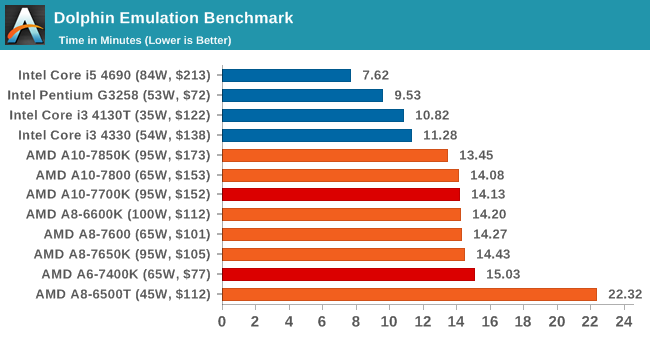
WinRAR 5.0.1: link
Our WinRAR test from 2013 is updated to the latest version of WinRAR at the start of 2014. We compress a set of 2867 files across 320 folders totaling 1.52 GB in size – 95% of these files are small typical website files, and the rest (90% of the size) are small 30 second 720p videos.
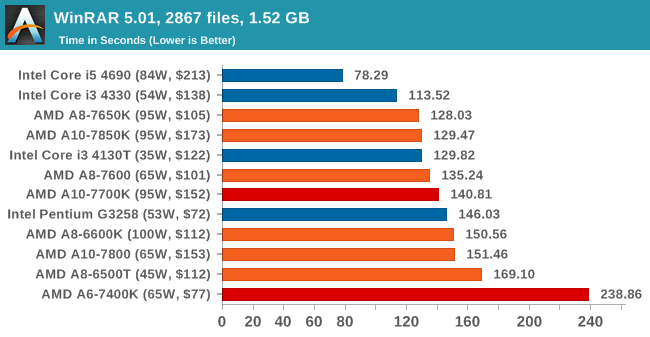
The single module of the 7400K shows the deficit in a slightly threaded workload.
Image Manipulation – FastStone Image Viewer 4.9: link
Similarly to WinRAR, the FastStone test us updated to the latest version. FastStone is the program I use to perform quick or bulk actions on images, such as resizing, adjusting for color and cropping. In our test we take a series of 170 images in various sizes and formats and convert them all into 640x480 .gif files, maintaining the aspect ratio. FastStone does not use multithreading for this test, and thus single threaded performance is often the winner.
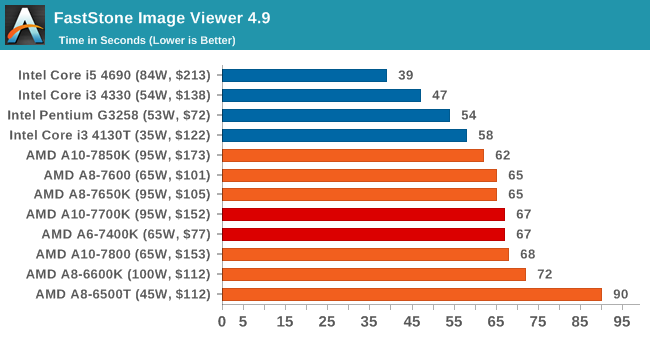
For a purely single threaded test, both of the AMD APUs performed similarly here.
Web Benchmarks
On the lower end processors, general usability is a big factor of experience, especially as we move into the HTML5 era of web browsing. For our web benchmarks, we take well known tests with Chrome 35 as a consistent browser.
Mozilla Kraken 1.1
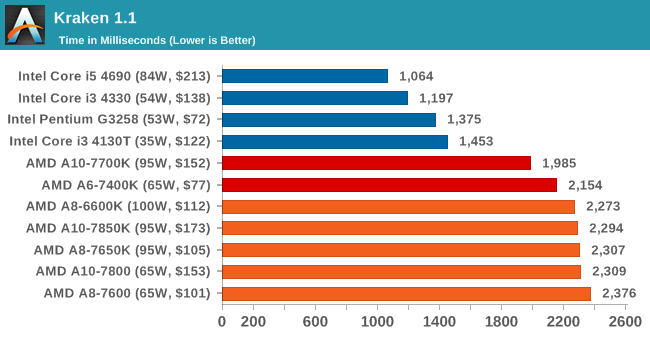
Google Octane v2

Professional Performance: Windows
We have a few benchmarks to characterise professional level performance on Windows.
Agisoft Photoscan – 2D to 3D Image Manipulation: link
Agisoft Photoscan creates 3D models from 2D images, a process which is very computationally expensive. The algorithm is split into four distinct phases, and different phases of the model reconstruction require either fast memory, fast IPC, more cores, or even OpenCL compute devices to hand. Agisoft supplied us with a special version of the software to script the process, where we take 50 images of a stately home and convert it into a medium quality model. This benchmark typically takes around 15-20 minutes on a high end PC on the CPU alone, with GPUs reducing the time.
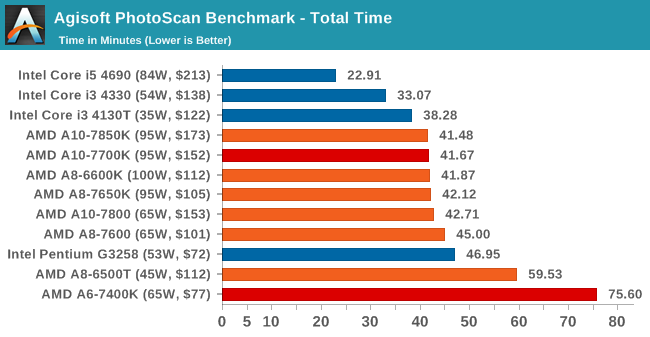
Cinebench R15
Cinebench is a benchmark based around Cinema 4D, and is fairly well known among enthusiasts for stressing the CPU for a provided workload. Results are given as a score, where higher is better.
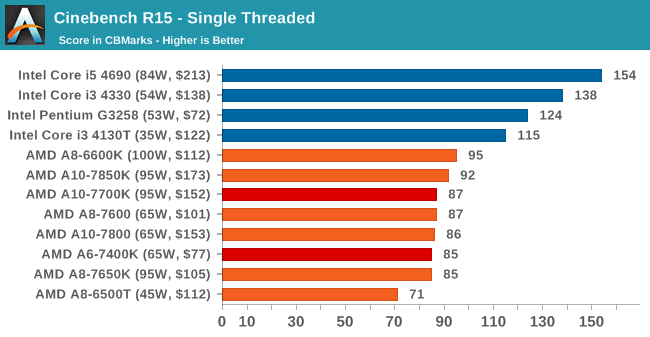

Linux Performance
Built around several freely available benchmarks for Linux, Linux-Bench is a project spearheaded by Patrick at ServeTheHome to streamline about a dozen of these tests in a single neat package run via a set of three commands using an Ubuntu 11.04 LiveCD. These tests include fluid dynamics used by NASA, ray-tracing, OpenSSL, molecular modeling, and a scalable data structure server for web deployments. We run Linux-Bench and have chosen to report a select few of the tests that rely on CPU and DRAM speed.
C-Ray: link
C-Ray is a simple ray-tracing program that focuses almost exclusively on processor performance rather than DRAM access. The test in Linux-Bench renders a heavy complex scene offering a large scalable scenario.
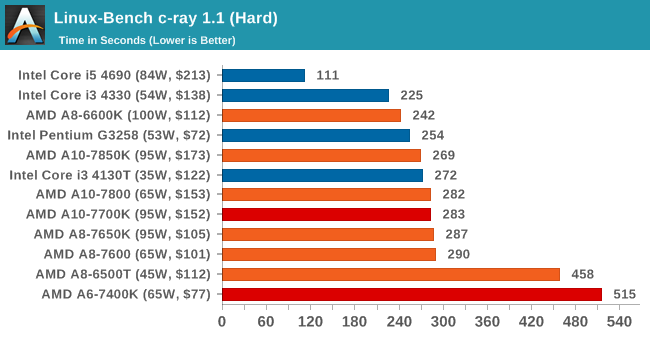
NAMD, Scalable Molecular Dynamics: link
Developed by the Theoretical and Computational Biophysics Group at the University of Illinois at Urbana-Champaign, NAMD is a set of parallel molecular dynamics codes for extreme parallelization up to and beyond 200,000 cores. The reference paper detailing NAMD has over 4000 citations, and our testing runs a small simulation where the calculation steps per unit time is the output vector.
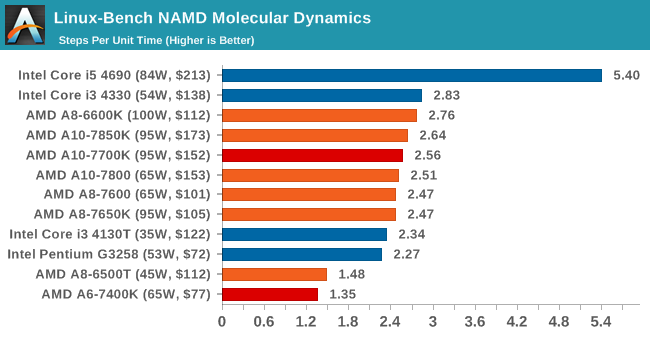
NPB, Fluid Dynamics: link
Aside from LINPACK, there are many other ways to benchmark supercomputers in terms of how effective they are for various types of mathematical processes. The NAS Parallel Benchmarks (NPB) are a set of small programs originally designed for NASA to test their supercomputers in terms of fluid dynamics simulations, useful for airflow reactions and design.











105 Comments
View All Comments
testbug00 - Wednesday, May 27, 2015 - link
godavari appears to just be Kaveri 2.0.Like Richland was to Trinity.
Clockspeed bumpbs, perhaps power reduction. No IPC increases.
MrSpadge - Wednesday, May 27, 2015 - link
I wouldn't call it 2.0 if it's just the same chips in different configurations (we should see soon if this is true). It's something they could mostly have done over a year ago.testbug00 - Wednesday, May 27, 2015 - link
It probably is a major stepping revision. Hence, it is a slightly different voltage/etc characteristics, but the same core layout.Edens_Remorse - Wednesday, May 27, 2015 - link
The improvement in stock cooling alone warrants a review. Athlon x4 860k/870k is an absolute gem for gaming. Too bad reviewers give us this year old b.s. knowing full well what is coming tomorrow.just4U - Wednesday, May 27, 2015 - link
I am perfectly ok with Ian reviewing these and getting them into the bench. The A6 part of the review was very welcome and it's nice to know that the A10 is actually more on par with the A8 which makes choices a little easier.A 870 or 860 review with the new coolers though.. hmmm ... "YES!" please do that if you can Ian. I've built a few systems with the 860 and it's crappy cooler.. which does the trick I suppose considering it doesn't run as hot as some of the A8/10s.
Alexvrb - Thursday, May 28, 2015 - link
The more chips that are in Bench the better.As far as coolers go, I will applaud improved coolers but on the other hand... aftermarket cooling is almost a must if you overclock regardless. Doesn't have to be extreme, there's some good budget heatsinks out there.
eanazag - Wednesday, May 27, 2015 - link
When the 7850K was at $178; it was too close to the i5 cores that it made no sense. It is much more competitive at $138. I'd really like to see it at $125.AMD makes sense on IGP only gaming at 720P. Or old games at 1080P.
Refuge - Wednesday, May 27, 2015 - link
Or just lower quality Textures at 1080p (Which makes the bad textures look even worse btw).Its that damn slow memory that hamstrings those iGPU's
Edens_Remorse - Wednesday, May 27, 2015 - link
You can buy the 7850k online today for $125. Cheaper if you live near a Microcenter($119). This "review" is pure b.s.mdriftmeyer - Wednesday, May 27, 2015 - link
Right, because $13 dollars is passed your price range.